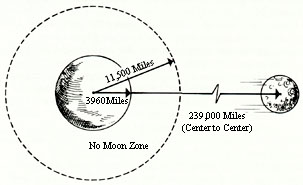
 Receding Moon Receding Moon
It takes but one proof of a young age for the moon or the earth to completely refute the doctrine of evolution. Based upon reasonable postulates, great scope of observational data, and fundamental laws of physics there is proof that the moon and the earth are too young for the presumed evolution to have taken place.
There is an easily understood physical proof that the moon is too young for the presumed evolutionary age. From the laws of physics one can show that the moon should be receding from the earth. From the same laws one can show that the moon would have never survived a nearness to the earth of less than 11,500 miles. That distance is known as the Roche limit. [1] The tidal forces of the earth on a satellite of the moon's dimensions would break up the satellite into something like the rings of Saturn. Hence the receding moon was never that close to the earth.
The present speed of recession of the moon is known. If one multiplies this recession speed by the presumed evolutionary age, the moon would be much farther away from the earth than it is, even if it had started from the earth. It could not have been receding for anything like the age demanded by the doctrine of evolution. There is as yet no tenable alternative explanation that will yield an evolutionary age of 4 billion years or more for the moon. Here is as simple a proof as science can provide that the moon is not as old as claimed. How does an evolutionist reconcile this proof that the moon is too young for the presumed evolution to have taken place? This known dynamical limit in the earth-moon system is a great problem to knowledgeable evolutionists. Robert C. Humes in his book Introduction to Space Science (John Wiley, 1971) acknowledges the problem and states that "The whole subject of the origin of the moon must be regarded as highly speculative." Dr. Louis B. Slichter, Professor of Geophysics at Massachusetts Institute of Technology treats this problem in great detail and concludes that "the time scale of the earth-moon system still presents a major problem."[2] It turns out that the earth-moon tidal friction causes the earth's spin rate to be slowing down. Lord Kelvin used that changing spin rate, assumed an initial molten earth, and proved that the earth could not be a billion years old, or the earth's present shape would be different. [3] Hence from theoretical and observational considerations there are two proofs that the earth-moon system can not be as old as a billion years. 1) The earth-moon spacing and recession rate refutes that long age.
2) The shape of the earth refutes that long age. Lunar Dust Depth
The prelunar landing predictions of evolutionary scientists gave great concern to the astronauts. Their predictions were that due to a presumed 4.5 billion year age of the moon and the rate of influx of dust and the lunar physical processes of rock break-up, the astronauts might be lost in a great depth of dust on the moon. [4] Fortunately the evolutionary predictions of great dust depth were wrong. Our astronauts were not lost in the predicted "quicksand" of age-accumulated dust on the moon. The creationist predictions of only a thin layer of dust were correct. This false prediction from evolutionary scientists lends support to the author's contention that the doctrine of evolution is a barrier to progress in science. Additional support for that contention can be found in the continual negative results of the evolutionary experiments to detect the presumed "evolved life forms" in space. Apparently one of the astronauts considered the lunar receiving laboratory to be a waste of time and money. To disprove the notion of evolved bacteria on the moon he offered to eat some of that dust. One should carefully note that the great successes of the NASA space program, of which we are all proud, were made possible by the tremendous advances in technology, not by evolutionary science. That technology is founded upon the proven laws of physics and chemistry and ingenious developments from the various fields of engineering.

Radiometric Evidence of Rapid Creation
 Dr. Robert V. Gentry has radiometric evidence that the basement rock of the earth was formed in a cool state, not in a molten condition. A cool initial state of the earth gives support to a young age for the earth. His research involves the study of pleochroic halos (colored spheres) produced by the radioactive decay of Polonium 218. He analyzed over one hundred thousand of these halos in granitic rocks which had been taken from considerable depths below land surface and in all parts of the world. Dr. Robert V. Gentry has radiometric evidence that the basement rock of the earth was formed in a cool state, not in a molten condition. A cool initial state of the earth gives support to a young age for the earth. His research involves the study of pleochroic halos (colored spheres) produced by the radioactive decay of Polonium 218. He analyzed over one hundred thousand of these halos in granitic rocks which had been taken from considerable depths below land surface and in all parts of the world. Two very important conclusions were drawn from this research 1) The Polonium 218 was primordial, that is to say, this radioactive element was in the original granite. 2) Because the halos can only be formed in the crystals of the granite, and the Polonium 218 half-life is only 3 minutes, the granite had to be cool and crystallized originally. The Polonium 218 would have been gone before molten granite could have cooled. It would take a very long time for a molten earth to cool.
The final conclusion can be summarized in this brief quote from one of Gentry’s technical papers: "The simple evidence of the halos is that the basement rocks of the earth were formed solid." "Halos in other minerals can be shown to give equally startling evidence of a young earth."[5] One needs to read some of Gentry's technical articles to see how clearly he established his conclusion that the Polonium 218 was primordial. That in itself presents problems to conventional radiometric dating. The conventional radiometric dating postulates would not jibe with this initial state which Gentry has identified.

Magnetic Evidence of a Young Earth
The known decay in the earth's magnetic field and the inexorable depletion of its energy clearly point to an imminent and inevitable end of the earth's magnetic field. A Department of Commerce publication lists evaluations of the strength of the earth's dipole magnet (its main magnet) since Karl Gauss made the first evaluation in the 1830's. It states that the rate of decrease is about 5% per hundred years. It then states that if the decay continues the magnetic field will "vanish in A.D. 3391." [6] This decay has some harmful environmental effects. The earth's magnetic field extends into the space around the earth. This provides a protective shield against cosmic rays and solar wind. The half-life of this decaying magnetic field is 1400 years (meaning that every 1400 years its strength is cut in half). The field strength is now only about one third as strong as it was at the time of Christ. More harmful radiation is penetrating down to the surface of the earth. This is an irreversible degradation of our environment. Horace Lamb predicted this decay in an 1883 theoretical paper on the source of the earth's magnetic field. Looking backward in time, in the light of his theory and the present known decay rate, and assuming the maximum plausible initial strength, puts an age limit on the earth's magnet of only a few thousand years.[7] Evolutionary geologists assume that there is some type of dynamo mechanism sustaining the earth's magnet. No one has yet come up with an acceptable theory for such a dynamo. That mechanism is supposed to be able to reverse the direction of the earth's magnet. They assume that this magnet has not been decaying continually but has reversed back and forth many times for billions of years. They must hold to a long age or it is the death knell for the whole theory of evolution. Reversal phenomena are "read" into the magnetization of accessible rocks in the crust of the earth. The literature shows real problems and some self-contradictions with those interpretations.[8]

Conclusion
The age of the earth and moon can not be as old as required in the doctrine of evolution, as has been shown when the great laws of physics are applied to observed large scale phenomena such as: 1) The recession rate of the moon and the Roche limit.
2) The faster earth spin rate in the past.
3) The rate of lunar dust build-up.
4) The decay of the earth's magnetic field.
5) The pleochroic halos in the earth's basement rock.

| 
